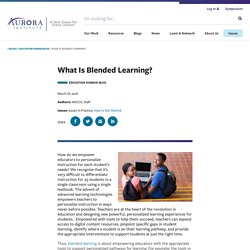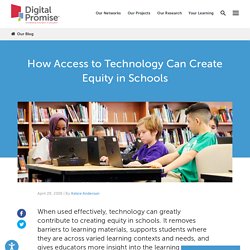Understanding Blended Learning and Equity
> Kinga3
What Is Blended Learning? - Aurora Institute. How do we empower educators to personalize instruction for each student’s needs?

We recognize that it’s very difficult to differentiate instruction for 25 students in a single classroom using a single textbook. The advent of advanced learning technologies empowers teachers to personalize instruction in ways never before possible. Teachers are at the heart of the revolution in education and designing new powerful, personalized learning experiences for students. Empowered with tools to help them succeed, teachers can expand access to digital content resources, pinpoint specific gaps in student learning, identify where a student is on their learning pathway, and provide the appropriate interventions to support students at just the right time.
Personalized vs. differentiated vs. individualized learning. Understanding the Inherent Challenges of Digital Equity in Blended Learning. Blended learning—a combination of both synchronous, in-person instruction and asynchronous online learning—continues to prove itself to be one of the most effective ways of teaching and learning.

In order for students to actually benefit from the blended learning model, digital equity must be addressed and foregrounded in schools and districts across the nation. It’s deeper than simply having access to a computer and an internet connection, though. Digital equity is ensuring that all students have: Access to hardware, software, and connectivity to the internet Access to meaningful, high-quality, and culturally relevant content Access to creating, sharing, and exchanging digital content Access to educators who know how to use digital tools and resources Access to high-quality research on the application of digital technologies to enhance learning There is no one-size-fits-all approach.
How Blended Learning Can Promote Equity and Inclusion. Blended learning is the combination of traditional classroom education and digital elements, such as interactive applications on a laptop or online homework and reading.

Many schools are embracing technology to promote learning. One area where technology performs particularly well is improving English language learner and low-income student outcomes. How Blended Learning Improves Inclusion. How Access to Technology Can Create Equity in Schools. When used effectively, technology can greatly contribute to creating equity in schools.

It removes barriers to learning materials, supports students where they are across varied learning contexts and needs, and gives educators more insight into the learning environments they’re creating. However, we can only realize these equity-centered benefits when we use technology in innovative and powerful ways. That means we shouldn’t just use edtech to replace worksheets, run “drill and kill” exercises, or crunch assessment performance numbers. To better understand how using technology can create equity in schools, we’ll outline how technology creates more equitable situations in the classroom.
Is technology driving educational inequality?
Those of us who work in digital learning believe that our work serves a larger social purpose.

Our belief system has at its core the idea of education as an engine of opportunity creation. We see digital technologies as a set of tools and methods that can, when properly utilized, be leveraged to expand educational access and increase quality.
Nine Evidence-based Teaching Practices That Combat Systemic Inequities in a Partially or Completely Online Setting. Brandeis’ distinctive leadership role in higher education requires that we apply the principles of access and social justice upon which Brandeis was founded in the present educational context that is partially or completely online.

Members of our Brandeis teaching community can provide equitable opportunities for all our students to engage by adopting evidence-based practices that reduce equity gaps in a partially or completely online educational context. Ablesar, J. and Moore, C. (2018).
3 ways to design for equity in distance learning this fall. Jun 25, 2020 More than nine million students lack internet access.

And at some schools, less than half of students participate in remote learning. These startling statistics reveal just how wide the gaps are in equitable learning experiences for all students.
Distant Equity: The Promise and Pitfalls of Online Learning for Students of Color in Higher Education - Race and Ethnicity in Higher Education. Download the Essay (PDF) 1.4 MB By Cameron Sublett Introduction.









